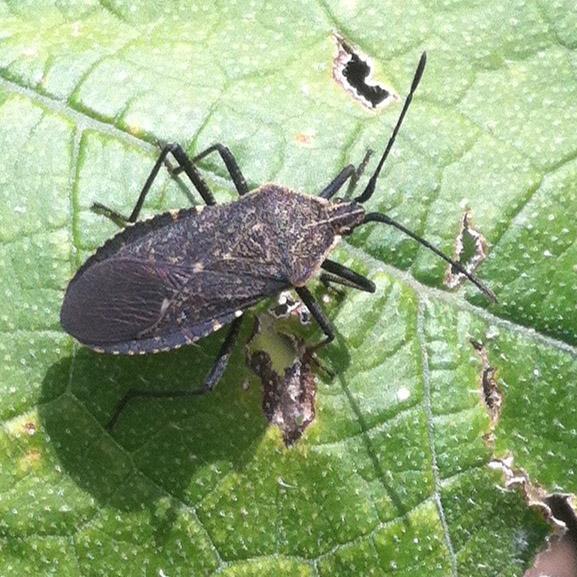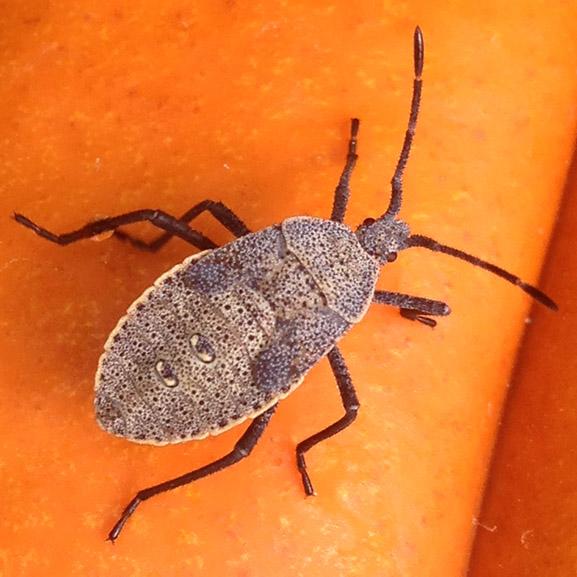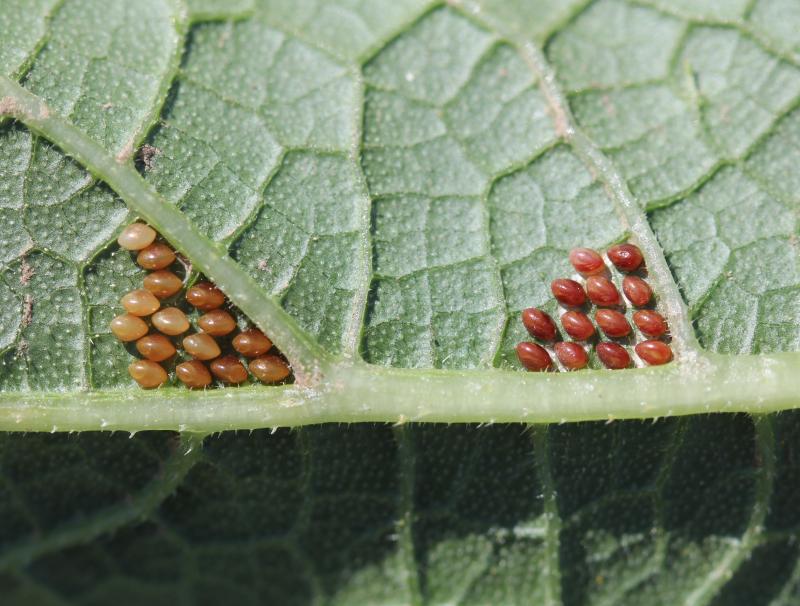With the end of summer approaching, we are beginning to receive many reports of squash bugs appearing throughout South Dakota. These insects are a common pest in gardens from mid-summer until the first frost. Squash bugs feed on most cucurbits, especially pumpkins and squash. They can be a difficult pest to manage later in the season, making prevention and early detection important.
About Squash Bugs

Identification
Adult squash bugs are approximately a ½ to ¾ of an inch long and have a flat, elongated body. They are mottled gray to dark brown in color with tan stripes running along the edge of their abdomen (Figure 1). The immature squash bugs, called nymphs, range in size up to ½ of an inch, depending on their developmental stage.

Nymphs start out with light green bodies that turn grey and eventually dark brown. Older nymphs will have a pattern of spots on the back with a tan border along the edge of the abdomen (Figure 2). All nymphs have black legs and antennae, regardless of age. Squash bug eggs are spherical and bronze colored (Figure 3).

Behavior
Squash bugs first appear in early summer when overwintering adults emerge to feed, mate, and lay eggs on growing cucurbits. The females lay eggs in clusters on the stems and undersides of the leaves between the leaf veins. Squash bug nymphs hatch in about 2 weeks and immediately begin feeding. Over the next 4 to 6 weeks, the nymphs complete their development and mature into adults. The adults continue to feed until the first frost when they seek shelter to overwinter. There may be one or two generations per year depending on the length of the growing season.
Nymphs and adults both feed by sucking the plant juices from the leaves and stems. The injury caused by extensive feeding can result in wilting or death of infested plants. Squash bugs are commonly found in groups on the leaves, stems, and fruit of cucurbits (Figure 4). When disturbed, they will produce a foul scent and scurry away quickly.
Management

There are several tactics to prevent a squash bug infestation. Avoid using mulches and clean up any debris around plants to eliminate shelter for squash bugs. Practicing crop rotation can greatly reduce their numbers as well. However, rotations will not completely keep squash bugs from showing up because of their ability to fly in from other sites. Floating row cover can be used over seedlings up until the first female flower is present. Row cover physically prevents the squash bugs from colonizing the plants, but it can be challenging to use in South Dakota because of wind. If you have infestations every year, consider using an early trap crop such as blue hubbard squash. Squash bugs tend to colonize the first suitable host in the environment, and a trap crop can serve as a lure that can then be treated and destroyed to greatly reduce squash bug populations. Simple fertilizing and watering of cucurbits is also advantageous, as it will make the plants more tolerant to feeding injury.
Early Detection
The key to managing a potential squash bug infestation is early detection. When plants are young, check the stems and leaves for egg clusters and crush any that are observed. It is impossible to eliminate all of the eggs this way, but it is a good preliminary strike that helps reduce populations later in the year. As the season progresses, continue to watch for nymphs and check cucurbits for wilting or discolored leaves, as these are signs of a possible infestation.
Insecticides
Physical removal of squash bugs may be effective if only a few plants are infested. For heavier infestations or if more plants are affected, insecticide treatments are recommended. Insecticides should be applied early in the season to manage nymphs because the adults are more resilient and difficult to kill. Several products can be used for squash bug management including carbaryl (Sevin), permethrin, and spinosad. For best results, make sure to get good coverage on the undersides of the leaves where squash bugs typically like to hide. If plants are flowering, be aware of pollinators and try to apply insecticides in a manner that does not directly harm them.